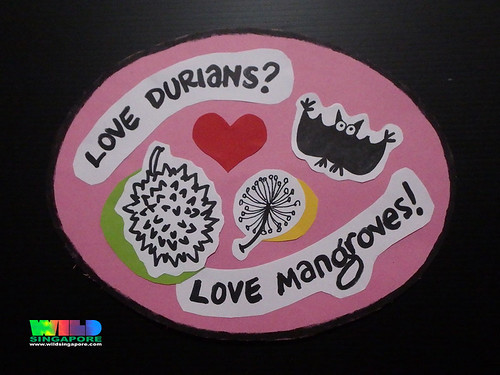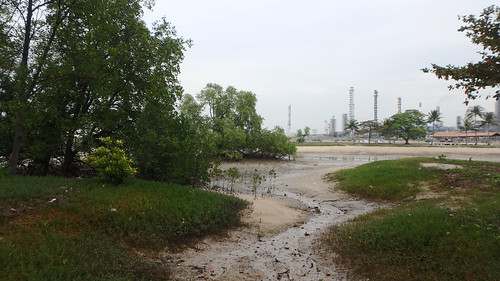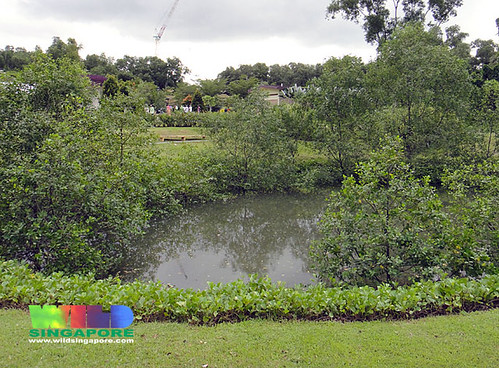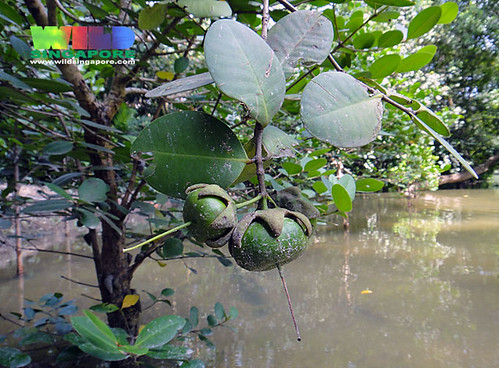First, let's think about what might pollinate durian flowers? Durian flowers are pom-pom shaped and open at night.
You guessed it! Bats pollinate these night blooming flowers! These bats eat the nectar and pollen of the flower.
How often do durian trees flower? Once or twice a year. If a bat were to rely only on durian flowers, it would starve to death!
Some mangrove trees have similar night blooming pom-pom shaped flowers. And they bloom more regularly, all year round. In Singapore mangroves, these include the beautiful and still commonly seen Perepat. And the rarer Berembang and Gedabu, both listed as Critically Endangered is the Singapore Red Data Book.
These mangrove trees support populations of bats, that also pollinate durian flowers when they bloom. Without mangroves, there would be less bats, and less durians! So let's love and protect our mangroves, so we can have bats and durians too!
More details ...
From Tomlinson, P. B., 1986. The Botany of Mangroves
The relationship between bats and flowers in west Malaysia were investigated extensively by Start and Marshall (1976), and it has also been shown to involve fruiting of the commercially important durian (Durio zibethinus Mull.). Durian is strongly seasonal in its fruiting; the main season is July following an extensive flowering in April. Durian flowers are pollinated almost entirely by a single species of bat, Eonycterus spelaea Dobson, a widely distributed nocturnal bat that roots primarily in large limestone caves, for example, Batu caves in Selangor. The bats are extremely fast flyers and may range up to 50km from their roosts each night in search of food in the form of pollen and nectar from a diversity of plants. This range includes the mangroves, and species of Sonneratia, especially S. alba, are important food sources for the bats at certain times of the year. The mangroves therefore may sustain bat populations when durians are not in flower. This interdependence among bat, mangrove, and durian is a demonstration of the complexit of the processes that underlie conservation measures. The destruction of both caves and mangroves can adversely affect the production of durian, a fruit that plays an important role in the rural economy of Malaysia because it is a favourite of the city dweller (Lee, 1980).
Where in Singapore can we see these Sonneratia mangrove trees?
Perepat is still among the more commonly seen mangrove trees in Singapore. A few magnificent trees welcome you at Ubin Jetty. Arriving in the early morning you may see some flowers that bloomed the night before.
There are a few large Perepat at Pulau Hantu too. Just opposite petrochemical plants at Pulau Bukom.
Berembang has been planted in many areas. At Pasir Ris Park near carpark B, a circle of these lovely trees have been planted around a tidal pool. They are accessible at night so you can actually see them in bloom.
At Sungei Buloh Wetland Reserve, there is a beautiful Berembang planted at the Wetland Centre. A Berembang tree has also been planted at Chek Jawa, Pulau Ubin, next to the Jejawi Tower. Although recently, it has fallen over.
Gedabu has also been planted at Pasir Ris Park mangrove boardwalk.
Related links
- "No Bats, No Durians" Nature Watch by the Nature Society (Singapore), Vol 6 No 2 Apr-Jun 1998
- Loss of Nectar Bats Threatens Durian Farmers, Merlin Tuttle's Bat Conservation, 3 May 2015
- Cave Nectar Bat on the Ecology Asia website.
- Eonycteris spelaea (Chiroptera: Pteropodidae) Cave Nectar Bat by Kelly Tan Siang Ting, 2014, on taxo4254.






